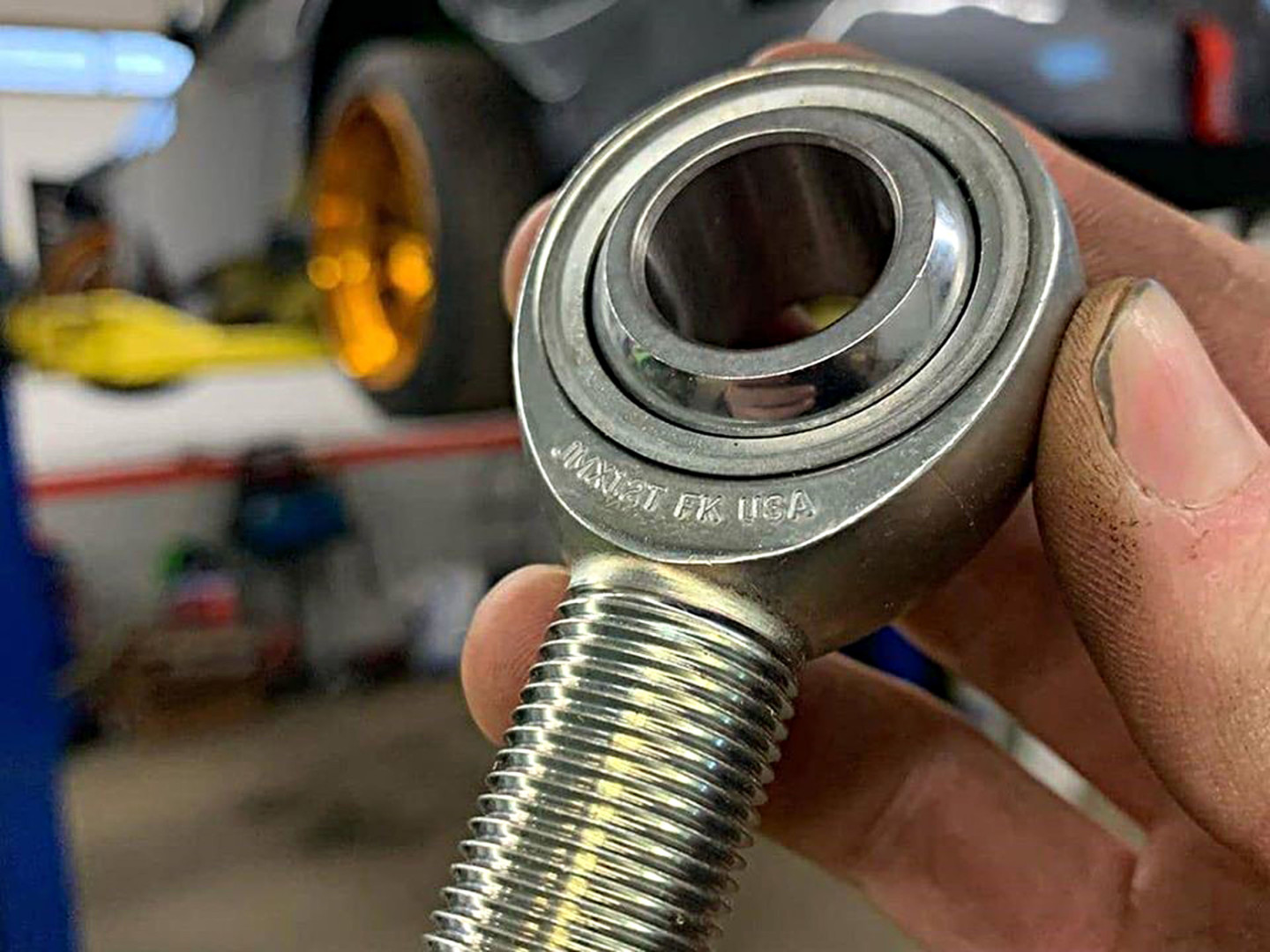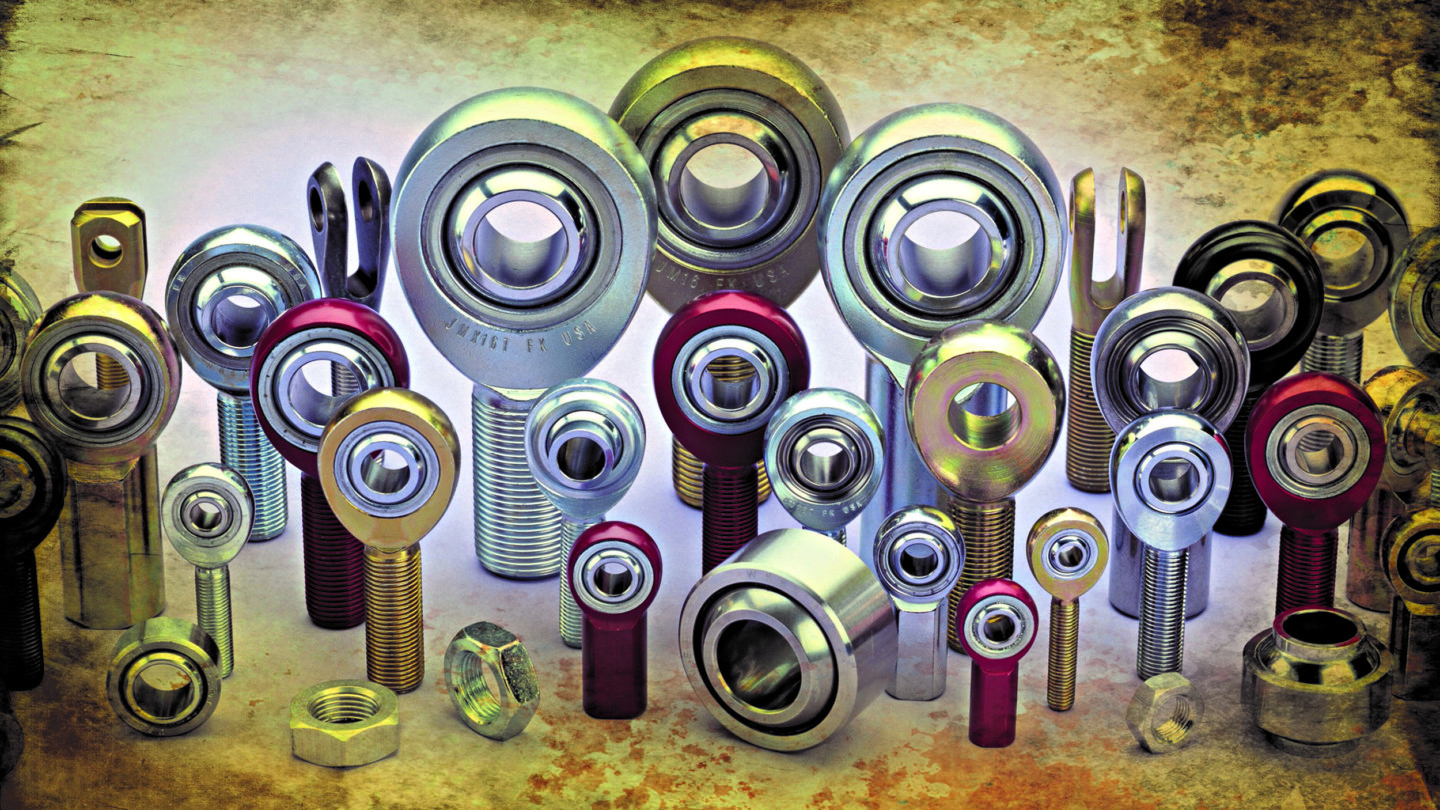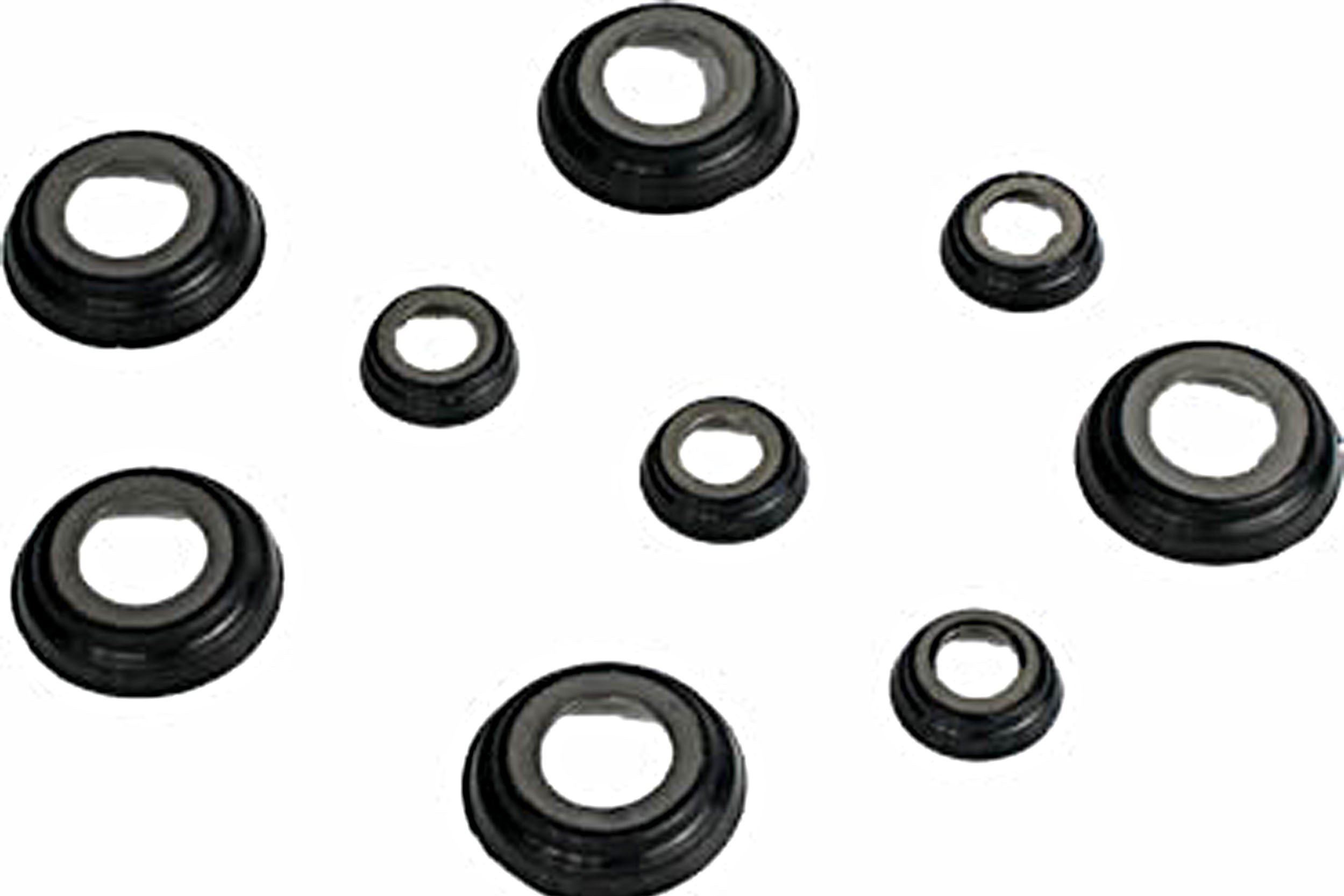It doesn’t matter whether you are launching from a sand dune or driving on the world’s smoothest road surface, a vehicle’s chassis is designed to move to the ebb and flow of the conditions to which it is subjected. How well it does that is determined by the components that make up the entire chassis.
OEMs build cars for the best compromise of stability, ride quality, and comfort. To do this, they rely on rubber joints to hold everything together and allow for flexibility when needed — but not necessarily when wanted. That is why many enthusiasts searching for higher-performing options will swap out their car’s rubber bushings for less-forgiving options.

Spherical rod ends provide a solid mount for many applications and have an unmatched ability to allow misalignment while still retaining strength and movement.
For those going far beyond the abilities of bushings, Southington, Connecticut-based FK Rod Ends has created a comprehensive line of rod end-joints which not only allow unprecedented misalignment abilities but also keep a precise hold on the designed chassis alignment settings as well. FK Rod Ends offers high-strength solutions for industrial and automotive applications, and a look at the website will clearly show the broad scope of what they offer.
Choosing The Right Rod End
We asked FK Rod Ends’ Jay Langley to help us illustrate the differences between the numerous offerings to help ensure the customer gets the right part for their application. “For motorsports, the popular rod ends vary, many times based on the manufacturer of the end product,” he says. “FK does have a team of knowledgeable in-house sales staff and engineers to assist with application and engineering questions.” So, if there is any question as to the best part for the job, simply emailing or calling the folks at FK is definitely an option.

One look at FK’s catalog shows the scope of offerings they provide. Jay breaks down the various uses for each category of rod end and the benefits of each one.
The FK website will also illustrate the numerous options available. Some specifications, such as bore diameter and either male or female threads, are dictated in their application. If there is an “F” in the product title (as in CM/CF) it comes in female as well as male.
FK Bearings manufactures more than 20 different series of commercial and precision rod ends with bore sizes from 1/8- through 2-inches and metric bores from 5mm through 30mm. Studded rod ends are available in inch sizes ranging from 3 through 12 and metric sizes 5 through 12. They offer a variety of materials and styles to suit a broad array of application requirements, ranging from Commercial/Industrial, Precision, Heavy Duty Shank, Metric, and Studded Rod Ends. They even offer special-sized rod ends for those applications not covered in the previous sections.

PTFE liners have many advantages which include eliminating the clearance or play between the ball and race as well as wipes away any contaminants that may try and get into the bearing surface.
Other popular options, such as lubrication fittings and polytetrafluoroethylene (PTFE) liners, are available on most series. PTFE is a strong, tough, waxy, non-flammable coating that resists debris sticking to it, and FK Rod Ends is one of the authorities in the industry on PTFE rod ends. We asked Jay to help us decipher the numerous options available and when a customer might choose one classification over another.
CM/CF Series: These are used in low-stress environments. They are a two-piece product consisting of a low carbon steel (mild steel) body with a hard-chromed alloy ball. You find these many times on various control linkages. Because of the inexpensive design, this product will develop extensive wear under extreme situations but can be had with a PTFE, Zerk, or stud option.
JM/JF series: You will find these used in moderately-stressed environments. They feature a low-carbon steel body, 52100 hard-chromed alloy ball, and a heat-treated race. This way, the wear parts are all hardened alloys and the body is mild steel. This product is best used for linkages and sway-bar end links, track bars, and offer PTFE, zerk, or stud options as well.
JMX/JFX series: These are designed for high-stress environments. The alloy body is heat-treated and used with a heat-treated race and 52100 hard-chromed alloy ball. Suspension components such as four-links, steering linkage, track bars, and control-arm pivots are popular uses for this type of rod end. PTFE, zerk, or stud options are available as well.
RJM/RJF series: These are moderate-stress units, just like the JM/JF series, but are chrome for the Harley, hot rod, and show truck/car crowd. You will find these used where a shiny appearance is more important than ultimate strength. They are available with a PTFE option only.
RSM series: Designated by the M, this is a male-only product. They are made exactly like the JM series, except the shank (thread size) is one size larger than the bore, offering extra strength.
RSMX series: This male-only product is made exactly like the JMX series, except the shank is one size larger than the bore, allowing for even more strength. These are used extensively in motorsports for control arm pivots and sway bar mounting. They are available with a PTFE, zerk, or stud option.
HJMX-T series: The H means this is engineered as a higher-misalignment rod end. FK’s JMX series is very similar, except it doesn’t allow as much misalignment as the HJMX, and doesn’t have the 4340-alloy body. You will find these used in motorsports in varying applications. The angle of misalignment is moderate, not extreme like you would get with FK’s misalignment spacers. A PTFE liner is standard on these rods.
HRSMX-T series: Another high-misalignment rod end, similar to the RSMX series, except for 4340-alloy body. The increased angle of misalignment is roughly a moderate, six-degree increase and not extreme like you would get with the misalignment spacers. Again, PTFE liners are standard with this rod end.
What About Severe Misalignment?
Being able to connect components on numerous planes is one of the benefits of using spherical rod ends. However, when the misalignment gets severe, even they need a little engineering help.
FK offers what they call misalignment spacers, which allow for even greater angles of misalignment, but at the expense of overall strength. Jay explains why this is the case. “To achieve the increased angle, the bore diameter on the ball of the rod end becomes smaller,” he explains. “The rod end itself is just as strong as it was made, but the bolt used to hold the product in place is smaller — by up to three sizes. A size 16 (1-inch) becomes a size 10 (5/8-inch) bore size. The angle of allowable misalignment, however, increases from 17 to 66 degrees. This is a massive change!”

Misalignment spacers allow for even more range of misalignment, but you need to be sure everything fits as it should so everything works as intended.
Jay explains how the need for such misalignment is not due to improper chassis design but uses engineering to provide the necessary strength. “Allowing this scope of misalignment is what makes a Score Trophy Truck, or similar truck in other racing classes, achieve close to 40-inches of wheel travel,” he says. “Prior to using rod ends and spherical bearings in off-road applications, 15-inches of movement was considered an outrageous amount of wheel travel. While strength is an issue as misalignment increases, most engineers use proper engineering to determine load and not have product fall apart.”

FK Rod Ends takes an engineering approach to misalignment to ensure that everything works as intended for the life of the product.
Likewise, Jay says using a PTFE-lined or lubricated rod end will not affect the angle of misalignment strength in any way, but if you are using misalignment spacers, you will want to make sure the spacers are machined for your specific rod end. If the spacer is not mated precisely to the ball or is engineered for another brand of rod end or spherical bearing, the PTFE could develop issues.
FK also offers various boots and seals to help seal off the rod end and prevent mud and grime from gumming up movement and shortening life expectancy. In most applications, a set of seals will keep out any unwanted debris, but in severe use applications, the rod end can be encased in a boot that prevents intrusion from the elements.
FK offers face seals that help keep the ball of the joint free from dirt and debris or they can be fully encased in a boot to protect the entire joint.
Both boots and seals do require regular cleaning, just like the rod end. The seals are much easier to install and can be used with rod ends or spherical bearings. The seals will not seal the end of the rod, only the mounting surface, and ball area. This keeps the race and ball area free of debris, allowing for smooth operation and rotation.
The Bottom Line
The use of spherical rod ends has allowed our world to move much more freely while eliminating any unwanted movement from the equation. But like any component, they need to be occasionally checked for wear and damage. Getting the right rod end for the job will not only ensure the part will give good service, but that it will also live a long, happy life while in service. Everything from throttle linkages to the most free-flowing suspension components can be made better by using the proper rod ends and a quick call to the folks at FK Rod Ends is one of the best ways to make that happen!




















